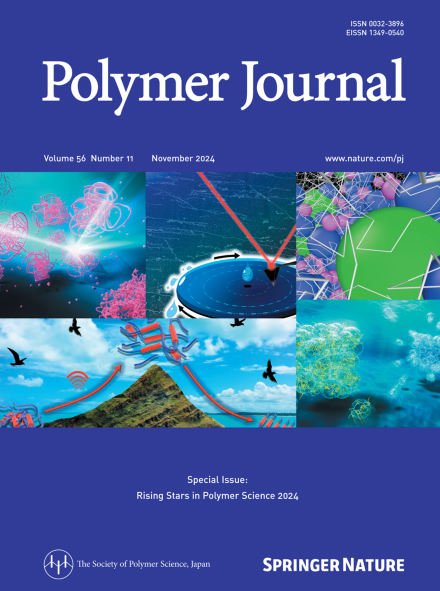应变结晶弹性体的泊松比转变:从橡胶无定形到半结晶
IF 2.7
4区 化学
Q3 POLYMER SCIENCE
引用次数: 0
摘要
研究了单轴拉伸过程中发生应变诱导结晶(SIC)的天然橡胶(NR)的泊松比(μ)与施加拉伸($${\lambda }_{{||}}$$)在$${\lambda }_{{||}}$$宽范围内的函数关系,包括SIC起始拉伸($${{\lambda }_{{||}}}^{* }$$≈4.1)。在$${{\lambda }_{{||}}}^{* }$$以下,μ保持在1/2附近,表明NR在完全橡胶非晶状态下具有不可压缩行为。然而,一旦$${\lambda }_{{||}}$$超过$${{\lambda }_{{||}}}^{* }$$, μ随着结晶度的增加而减小(χc)。当$${\lambda }_{{||}}$$从$${{\lambda }_{{||}}}^{* }$$增加到骨折拉伸($${\lambda }_{{||}}$$≈7.1)时,χc增加到18%, and μ gradually decreases to 0.33. This reduction in μ reflects the transformation of the NR matrix from a rubbery amorphous state to a semicrystalline state. In fact, the true stress (force per cross-sectional area in the deformed state) at the fracture point, obtained via actual lateral contraction, is approximately 85% of that estimated under the assumption μ = 1/2. These findings provide a critical foundation for accurately modeling the mechanical behavior of strain-crystallizing elastomers. The Poisson''s ratio (μ) of natural rubber undergoing strain-induced crystallization was studied across a broad stretch range. Below the crystallization onset stretch ( $${\lambda }_{{||}}$$ * ≈ 4.1), μ remains near 0.5, indicating incompressibility. Beyond $${\lambda }_{{||}}$$ *, μ decreases with increasing crystallinity, reaching 0.33 at fracture ( $${\lambda }_{{||}}$$ ≈ 7.1), as the matrix transforms from amorphous to semicrystalline. The true stress at fracture, accounting for lateral contraction, is approximately 85% of the estimated value assuming μ = 0.5. These insights are vital for modeling the mechanical behavior of strain-crystallizing elastomers.本文章由计算机程序翻译,如有差异,请以英文原文为准。

Poisson’s ratio transition in strain crystallizing elastomer: from rubbery amorphous to semicrystalline
The Poisson’s ratio (μ) of natural rubber (NR) undergoing strain-induced crystallization (SIC) during uniaxial stretching was investigated as a function of the applied stretch ( $${\lambda }_{{||}}$$ ) over a broad $${\lambda }_{{||}}$$ range, encompassing the SIC onset stretch ( $${{\lambda }_{{||}}}^{* }$$ ≈ 4.1). Below $${{\lambda }_{{||}}}^{* }$$ , μ remains near 1/2, indicating the incompressible behavior of NR in its fully rubbery amorphous state. However, once $${\lambda }_{{||}}$$ exceeds $${{\lambda }_{{||}}}^{* }$$ , μ decreases as the degree of crystallinity (χc) increases. As $${\lambda }_{{||}}$$ increases from $${{\lambda }_{{||}}}^{* }$$ to fracture stretch ( $${\lambda }_{{||}}$$ ≈ 7.1), χc increases to 18%, and μ gradually decreases to 0.33. This reduction in μ reflects the transformation of the NR matrix from a rubbery amorphous state to a semicrystalline state. In fact, the true stress (force per cross-sectional area in the deformed state) at the fracture point, obtained via actual lateral contraction, is approximately 85% of that estimated under the assumption μ = 1/2. These findings provide a critical foundation for accurately modeling the mechanical behavior of strain-crystallizing elastomers. The Poisson''s ratio (μ) of natural rubber undergoing strain-induced crystallization was studied across a broad stretch range. Below the crystallization onset stretch ( $${\lambda }_{{||}}$$ * ≈ 4.1), μ remains near 0.5, indicating incompressibility. Beyond $${\lambda }_{{||}}$$ *, μ decreases with increasing crystallinity, reaching 0.33 at fracture ( $${\lambda }_{{||}}$$ ≈ 7.1), as the matrix transforms from amorphous to semicrystalline. The true stress at fracture, accounting for lateral contraction, is approximately 85% of the estimated value assuming μ = 0.5. These insights are vital for modeling the mechanical behavior of strain-crystallizing elastomers.
求助全文
通过发布文献求助,成功后即可免费获取论文全文。
去求助
来源期刊

Polymer Journal
化学-高分子科学
CiteScore
5.60
自引率
7.10%
发文量
131
审稿时长
2.5 months
期刊介绍:
Polymer Journal promotes research from all aspects of polymer science from anywhere in the world and aims to provide an integrated platform for scientific communication that assists the advancement of polymer science and related fields. The journal publishes Original Articles, Notes, Short Communications and Reviews.
Subject areas and topics of particular interest within the journal''s scope include, but are not limited to, those listed below:
Polymer synthesis and reactions
Polymer structures
Physical properties of polymers
Polymer surface and interfaces
Functional polymers
Supramolecular polymers
Self-assembled materials
Biopolymers and bio-related polymer materials
Polymer engineering.
 求助内容:
求助内容: 应助结果提醒方式:
应助结果提醒方式:


